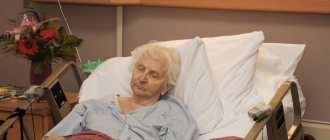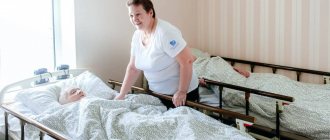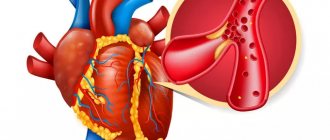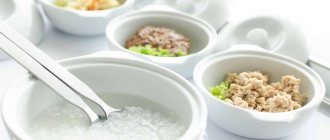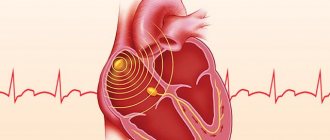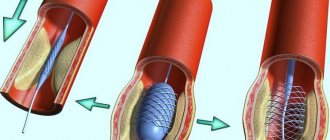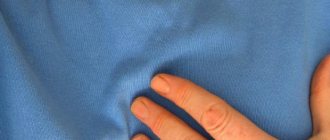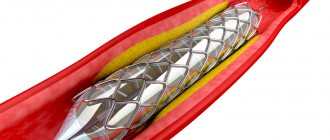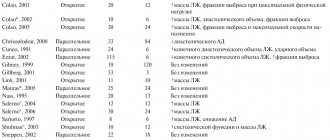Among diseases that can suddenly worsen and lead to extremely negative consequences, myocardial infarction is especially dangerous. Treatment should be started as early as possible. At the initial stage, it may consist of first aid, and the rehabilitation stage can last for several months. The patient is provided with comprehensive care, including drug treatment, surgical and non-surgical methods, and rehabilitation therapy aimed at eliminating the symptoms of the disease. With a professionally designed recovery program, life after a heart attack can return to normal, subject to certain restrictions.
Stages of treatment of myocardial infarction
- At the prehospital stage, if there are symptoms of the disease, the patient is given first aid and transported to the clinic.
- The hospital stage involves carrying out medical measures aimed at maintaining body functions and combating negative consequences.
- The rehabilitation stage is carried out in sanatoriums where special conditions have been created.
- At the stage of dispensary observation and outpatient treatment, the patient periodically visits the cardiology clinic and the doctor at his place of residence.
The high professionalism of doctors and the technical equipment of the clinic where you are being treated after a myocardial infarction are extremely important. With qualified specialists and high-quality rehabilitation, you will avoid complications and continue to live a full life.
Rehabilitation after discharge from hospital
Treatment and monitoring of the patients’ condition continues at the stage of a rehabilitation center or a sanatorium specialized in cardiac rehabilitation. Objectives of the stage: stabilize the physical and psychological state of a person, awaken motivation to lead a healthy lifestyle and adapt to his regime.
During this period the patient receives:
- individual rehabilitation program - pharmacological support and physical recovery;
- practical correction of risk factors: control of blood pressure, blood sugar and cholesterol levels - after a diagnosis of heart attack, this is especially important.
- psychological assistance - analysis of personal characteristics and characteristics of the reaction to illness, psychological support;
- training in healthy lifestyle skills and self-regulation of the body, preparation for returning to work, family and society;
- recommendations for future life - drug therapy and observation, nutrition and physical activity program, lifestyle in its most important manifestations.
The most important process of recovery takes place in the rehabilitation center: the effect of medications is fully revealed, and the contact between the patient and the doctor is as productive as possible. The rehabilitation period is about 3 weeks: 18-21 days.
Let us note that only a center can cope with the task, which combines extensive experience, a solid methodological base and qualified specialists: a cardiologist, psycho- and physiotherapist, doctors and exercise therapy instructors with special training, laboratory and functional diagnostics specialists.
Close cooperation between the patient and medical staff, a positive attitude and a favorable climate also help to minimize the risk of a recurrent attack and return to a harmonious life.
First aid for myocardial infarction
Every person should be able to provide emergency care for myocardial infarction, because most people suffer from cardiovascular diseases, and the risk of developing this pathology is extremely high.
At the first symptoms, you must immediately call an ambulance, preferably a specialized cardiac team equipped with a defibrillator, pacemaker, and medications.
While you are waiting for the doctors, give the patient nitroglycerin under the tongue, analgesics, aspirin, Corvalol or Valocordin. If the patient suffers from arrhythmia, antiarrhythmic drugs will be needed.
If acute myocardial infarction is accompanied by cardiac catastrophe and loss of breathing, resuscitation should be started immediately. Lay the patient down, open his mouth slightly and cover him with a handkerchief. Exhale deeply through the handkerchief into the patient's lungs. Pinch his nose to prevent air from escaping.
While the patient's chest spontaneously lowers, straighten up, take a breath and repeat the manipulation several times. If there is no pulse in the carotid artery, indirect cardiac massage is necessary. The classic formula includes 15 chest compressions for 2 consecutive air injections. Actions must be continued until the patient’s skin turns pink, the pupils constrict, and a pulse appears.
Magazine "PARTNER"
“Partner” No. 8 (227) 2021
Matters of the heart
Dr. Olga Grishchenko (Heppenheim)
Recovery after myocardial infarction
In Germany, people who have suffered a myocardial infarction, after treatment in a clinic, usually receive a referral to a resort, where, under the supervision of specialists, they recover from the illness. But both those who recovered at the resort and those who have not been to the resort will find the following information useful.
Do not rush to turn the page, as this material is intended not only for those who, unfortunately, have already experienced the manifestations of coronary heart disease (CHD), but also for all young people, full of health and strength, who have not yet thought about how to maintain your health and well-being.
Unfortunately, without wanting it ourselves, we often create numerous problems for our heart, sometimes putting it in unbearable conditions. The rhythm of modern life with constant stress, an excess of negative information, poor ecology, a sedentary lifestyle and poor nutrition often turn out to be serious tests for the entire cardiovascular system, which was originally designed for healthy and active activity in a good environment and has not changed since our times distant ancestors.
Did you know that according to official statistics, heart disease claims more than six million lives every year in the world? According to the conclusion of the World Health Organization, the incidence of coronary heart disease (CHD) and myocardial infarction (MI) has long assumed the character of a kind of epidemic. In addition, myocardial infarction and atherosclerosis have become significantly younger. Nowadays, MI is not uncommon for people aged 30 years, but for those who are 40-50 years old, it has become commonplace, which makes the problem under consideration especially acute and relevant.
Of course, practical medicine has made significant progress in the treatment of MI; The best specialists and the most advanced achievements of mankind are involved in the fight against the “number one killer” in the world, but the prevention of cardiovascular diseases, unfortunately, does not always achieve the desired results. Most often, a person learns how to deal with a heart attack too late, having already become a victim, and hopes, first of all, for the help of modern medicine. Well, this is quite natural!
“No matter how skillful the specialists are who treat you and help you recover at the resorts, there comes a moment when you yourself become the master of your health, and it is up to you whether you will return to a full life and work or whether you will remain helpless and sick.”
A heart attack is successfully treated only if the patient is not passive and actively helps the doctor in the fight against the disease. A calm, good mood, positive emotional tone, like magical “living water,” contribute to the rapid healing of damaged heart muscles and normalization of its functioning. A person who has suffered a myocardial infarction should not “go into illness” (although this is sometimes very difficult, especially at first). It is necessary to tune in to a favorable outcome, knowing, however, that healing of the damaged myocardium will require a long time (3-4 months) and a certain regimen that must be strictly and consistently followed.
Diet
The success of treatment largely depends on whether you follow the recommended diet. The purpose of the diet after a heart attack is to create gentle conditions for the cardiovascular system, strengthen the myocardium, and activate the process of removing nitrogenous waste and under-oxidized metabolic products from the body. It is recommended to eat at least four times a day, in small portions, the last meal should be no later than 2-3 hours before bedtime; in the evening it is better to drink a glass of low-fat yogurt or juice. It is advisable to exclude hot seasonings, smoked foods, strong tea and coffee, which excite the nervous system and provoke vascular spasms, as well as foods rich in cholesterol.
In addition, it is necessary to limit the amount of free liquid (1.2-1.5 liters per day, including liquid included in dishes), reduce the consumption of table salt and mainly include foods that have a reduced calorie content due to the restriction of fat in them. Of the vitamins, ascorbic acid (vitamin C) is especially important, as well as B vitamins. Potassium salts contained in raisins, dried apricots, prunes, and potatoes have a beneficial effect on myocardial contractility, dilate blood vessels and increase urine excretion. Magnesium salts (there are many of them in nuts, rose hips, soybeans, figs) - lower blood pressure, have a calming effect on the nervous system, and reduce cholesterol levels in the blood.
Physiotherapy
At the resort you will definitely do therapeutic exercises. Before you start exercising, your doctor will determine your level of physical activity. The intensity of the load will depend on this. However, there are universal rules for performing any complex of therapeutic exercises after a myocardial infarction:
1. You can exercise only if you feel well.
2. If you feel unwell, shortness of breath or pain in the heart area, the load must be reduced or stopped altogether.
3. The duration of classes should not exceed 20-30 minutes.
4. Exercises are performed without sudden movements; the load increases gradually.
5. Classes must be carried out in a ventilated room, clothing should be light and not restrict movement.
6. While performing breathing exercises, inhale smoothly, with moderate depth, through the nose. Exhalation is through the mouth; it is longer and slower than inhalation.
7. Walking on level ground is measured by distance, number of rest stops, pace, and duration of the walk.
8. Training is carried out first once a day, in the morning, then in the afternoon, at least two hours before bedtime.
9. Those who started training at the resort should definitely continue them at home.
All issues of changing the motor mode must be agreed with a doctor and specialists in therapeutic exercises.
The Importance of Self-Control
In order to correctly calculate your strength during physical activity, you need to learn self-control, the main criterion of which is your well-being. An absolute contraindication for training is pain in the heart, chest, intense shortness of breath, cold sweat, increased heart rate (more than 120 beats per minute), general fatigue, pain in the legs and joints. If such complaints appear, you should immediately stop any physical activity and inform your doctor about your condition.
Unfortunately, some people mistakenly believe that with such symptoms one should not stop exercising, but the pain should be overcome. This dangerous misconception can lead to tragic consequences.
There is another extreme, when a person who has suffered a heart attack completely immerses himself in illness and is afraid of any, even the most insignificant, physical activity. This behavior is also wrong.
It is known that an attack of angina develops when the need for oxygen consumed by the heart muscle is not met due to the inability of the coronary artery to deliver it. Physical exercises specially selected by a specialist, performed at a slow pace, as well as breathing exercises mobilize extracardiac circulatory factors, help activate the arterial and venous beds, thereby facilitating the work of the heart, improve metabolism, increasing the absorption of oxygen and nutrients by tissues, normalize the functioning of the excretory organs (kidneys, sweat glands), intestinal mucous membranes. All of the above leads not only to an increase in physical performance, but also to a significant improvement in the psychological state of the patient. Mood improves, fear of physical activity disappears, and self-confidence appears.
Universal Council of Cardiologists of the World
Step by step, a person suffering from coronary artery disease and having had a heart attack must restore his health and return to a normal lifestyle. And on this path he needs positive emotions so much! Do not forget about the well-known truth: you need to respect the whole world, starting with yourself. Give others your generosity and kindness, positive emotions and good mood. This must be done sincerely, openly, and not under duress, since violence against oneself, insincerity, even with a “plus” sign, do not give a positive therapeutic result. By “feeding” those around us with our true kindness and attention, we simultaneously restore our spiritual potential, receiving in return a charge of positive emotions. Friends and loved ones, good books and films, warm family relationships are the basis for the prevention of all cardiovascular diseases.
Drug treatments for myocardial infarction
The purpose of using medications in the hospital is to restore and maintain circulatory functions, as well as relieve unbearable pain.
- Painful sensations can be eliminated with the help of analgesics, and the feeling of fear can be eliminated with tranquilizers.
- To prevent the formation of a blood clot, acetylsalicylic acid and anticoagulants are used.
- If a blood clot has already formed, powerful thrombolytics are used to dissolve it.
In the treatment of acute myocardial infarction, a special place is given to thrombolytic therapy to eliminate the risk of new blood clots. Arrhythmia is a common occurrence in this disease, so the patient is offered antiarrhythmic drugs, adrenergic blockers, nitrates, and vitamin E.
Rehabilitation after acute myocardial infarction involves taking medications to maintain normal blood pressure and prevent blood clots.
Angioplasty and coronary artery stenting
One of the effective and widespread methods of treating acute myocardial infarction throughout the world is coronary angioplasty with the possibility of installing a stent. The advantage of the operation is that it is extremely minimally traumatic: a small puncture is sufficient to insert a catheter into a peripheral vessel (usually the femoral artery serves as a transport vessel). The goal of high-precision manipulation is to widen the coronary artery in the place where it is blocked.
The catheter, under the control of X-ray equipment, is passed through the vascular system to the site of narrowing of the coronary artery. At the end of the catheter there is a miniature balloon, which is in a compressed state. An X-ray contrast agent is injected into the vessels, and the doctor has the opportunity to observe the manipulations on monitors in the operating room. The cardiac surgeon places a balloon in the affected area of the vessel and inflates it with special equipment, thereby restoring blood flow.
To prevent the walls of the artery from narrowing again, a cylindrical stent is inserted into it in the same way and secured. Thus, it replaces the affected area of the vessel.
Coronary artery bypass grafting
It is also a very effective method of treating myocardial infarction. The purpose of this operation is to create a new path for the blood, bypassing the vessel affected by atherosclerosis. For this, a special shunt is used - a part of the patient’s own vessel, taken from the thoracic artery or radial artery of the arm. It is sewn into the narrowed or blocked artery above and below the site of the lesion. Thus, the volume of blood required for heart function is normalized. Doctors are able to restore blood circulation in the affected area of the heart muscle in a short period of time.
The operation eliminates the very cause of the heart attack and is often performed as planned so that the patient can avoid a heart attack. The risk of developing a heart attack after surgery is significantly reduced, and the patient regains ability to work with a normal amount of physical activity.
Coronary artery bypass grafting is a type of open intervention for a beating heart. That is, to carry it out it is necessary to open the chest. There are options for surgery with or without artificial circulation.
Psychological rehabilitation
Any disease is stressful. Urgent hospitalization, the need for long-term treatment, and sometimes surgical intervention, and a sharp restriction of activity often become the causes of quite serious mental changes. Therefore, at all stages of rehabilitation, psychological and psychotherapeutic work is carried out with the patient.
A big role in recovery is played by the patient’s attitude, attitude and support of loved ones.
It is also important to overcome the fear of physical activity and form an adequate assessment of your capabilities. Patients feel differently about their condition. There are those who are afraid to make unnecessary movements and delay rehabilitation, and those who underestimate the severity of the disease and too quickly strive to return to their usual rhythm. The doctor’s task is to give an objective assessment, explain the tasks of each stage of rehabilitation and the acceptable level of activity.
At the stage of outpatient observation, it is important to prevent the development of neurosis and depression, which occur in many patients4 and can negatively affect adaptation capabilities.
Myocardial infarction: rehabilitation and life after an attack
At the rehabilitation stage, it is important to gradually expand the patient’s activity. For this purpose, professional cardiology clinics and sanatoriums use modern programs aimed at preventing and treating muscle atrophy and pulmonary congestion. They include physical therapy and physiotherapy.
Life after a myocardial infarction does not end at all if the patient is offered a competent and effective rehabilitation program. In some cases, the patient will have to change his job if it involves physical or emotional stress.
Diet after myocardial infarction
Life after a heart attack involves following a diet with foods that do not put a strain on the vascular system. Nutrition after myocardial infarction should include easily digestible food, and it should be taken 5-6 times a day in small portions. The diet should include cereals, low-fat dairy products, juices, vegetables, and dried fruits.
The most strict diet is during the hospital period. It includes unsalted liquid porridges, vegetable soups made from ground products. In the future, nutrition will be normalized. Coffee, tobacco, and alcohol are strictly prohibited!
Types of rehabilitation
The attending physician individually selects a rehabilitation program, taking into account the severity of heart failure, the severity of the condition, the presence of complications and other diseases, the nature of the heart attack, the age and physical fitness of the patient.
There are several types of rehabilitation:
- Medication;
- Physical;
- Psychological.
Drug rehabilitation
People who have had a heart attack must take medications.
In some cases, in addition to medication, surgical treatment may be necessary - stenting or coronary artery bypass grafting.
At the post-hospital and maintenance stages, the attending physician prescribes medications individually, taking into account the characteristics of the body, concomitant diseases, and the causes of thrombus formation. Regular monitoring of the condition is very important, which will allow the treatment to be adjusted at the slightest deterioration.
Physical rehabilitation
Particular attention is paid to the restoration of physical skills. This process must take place gradually. In the hospital, the patient relearns how to turn over in bed and sit, wash his face and brush his teeth. After some time, he begins to perform the simplest exercises and move around the ward. At the next stage, he is allowed to walk along the hospital corridor and then go up and down the steps.
In the post-stationary period, the loads are gradually increased.
Physical activity should include:
- Domestic activity - housework, gardening and gardening (hard work and heavy lifting are strictly contraindicated);
- Physiotherapy exercises – the doctor selects a set of exercises individually;
- Measured walking (terrenkur) - regular (walking) and Scandinavian, as well as going up and down the stairs;
- Cardio exercises (exercise bikes, treadmills, walking simulators, stair climbing simulators, skiing, rowing);
- Aerobic exercise (jogging, skiing, cycling, swimming, yoga).
At first, it is enough to practice every day for a quarter of an hour. Every week the duration of the classes is increased by five minutes until they reach an hour. You need to know that in the absence of physical activity, the likelihood of another heart attack increases by 25%. But you shouldn’t put too much stress on your body, which can also trigger a heart attack. Loads must be dosed and correspond to the person’s capabilities.
Mental rehabilitation
In the first month, you should pay increased attention to the psychological state of a person who has had a heart attack. It is at this stage that he especially acutely feels his helplessness, begins to realize the consequences of the disease, and experiences fear of a new attack. Therefore, the patient becomes nervous and irritable, and may show aggression, which often becomes the cause of depression or neurosis. In this case, you will need the help of a psychologist. A specialist will help you accept the situation and get rid of negative thoughts, tune in to the positive and believe that a normal life is possible even after a heart attack, and teach you how to control your emotions. Positive thinking will significantly speed up your recovery.
What is included in the post-infarction rehabilitation program
In addition to drug treatment, restoration of physical performance and stabilization of the psychological state, the rehabilitation program involves following a diet and maintaining a healthy lifestyle.
Diet
A properly formulated diet will not only help restore the body after a serious illness, but also prevent relapse. In the first days, the patient is given small portions to reduce the load on the heart. The menu consists of soups and vegetable purees without adding salt or spices.
In the future, you will have to follow the principles of rational nutrition:
- Eat often, but little by little;
- Avoid unhealthy foods (fried and fatty foods, spicy foods, sauces, smoked meats, spices, pickles, canned food, sweets, fast foods, processed foods, coffee);
- Increase consumption of seafood, vegetables and fruits, fish, lean meat, dairy products;
- Drink no more than one and a half liters of liquid per day.
If you are overweight, you need to lose weight. To do this, you should reduce the caloric content of food. Under no circumstances should you “go on” a strict diet.
Lifestyle
To prevent a second attack, you will have to “forget” about bad habits: quit smoking and stop drinking alcoholic beverages. It is also necessary to fully rest and sleep for at least 8 hours, refuse to visit the steam room, bathhouse and sauna, learn to avoid stress and dose physical activity, formulate the correct life guidelines, remain calm and emotionally stable.
Regular preventive examinations with a cardiologist, laboratory tests, ultrasound, ECG and stress tests are required, which will allow timely detection and prevention of possible complications.
Treatment and rehabilitation after myocardial infarction using shock wave therapy
One of the effective methods of treating coronary heart disease, allowing you to avoid a heart attack or restore the body after the disease. It is used in cases where traditional methods of coronary artery bypass grafting and stenting are contraindicated or do not produce any effect.
Specialized equipment uses an ultrasound scanner to focus acoustic waves onto the area of myocardial ischemia. With non-contact exposure, new vessels are formed, resulting in a bypass effect - the blood supply to the heart improves, the number of angina attacks decreases.
The method is attractive due to its absolute painlessness. During the procedure, blood pressure does not change and heart rhythm is not disturbed. No side effects were recorded. After a course of procedures, you will be able to increase physical and emotional stress, and reduce the amount of medications consumed.
On the topic “Shock wave therapy for coronary heart disease,” watch the recording of the program “About the Most Important Thing” on Russia 1 channel, which was filmed with the participation of our cardiologist Elena Pisanko. The filming contains a clear example of the procedure itself, which took place in our clinic.
Diet
A properly formulated diet helps restore the body after illness and prevents relapse. The daily diet is divided into four to five meals, the last of which is two hours before bedtime. Portion sizes should be small.
The menu is being adjusted step by step. In the first days, light dishes without salt and spices are recommended.
In the future, the range of products is expanded due to:
- croup;
- seafood;
- vegetables, fruits, nuts;
- bran bread;
- vegetable oils;
- kefir and other low-fat fermented milk products;
- lean varieties of meat and fish.
Limit:
- yolks (2 pieces per week);
- sugar and products containing it (no more than 50 g per day);
- cream and butter (10-20 g);
- salt (up to 0.5 tsp per day).
Excludes:
- refractory fats, lard, offal;
- sauces, pickles;
- sausages, canned food, semi-finished products;
- caviar, fatty meats;
- strong broths;
- fatty cheeses;
- chocolate, ice cream, cream;
- coffee, soda;
- fast food.
Products are steamed, boiled, stewed, baked. Fried and smoked foods are prohibited. Fluid intake is 1.5 liters per day. If you are overweight, you can reduce it by following a gentle diet (without fasting).
Treatment and rehabilitation after myocardial infarction using enhanced external counterpulsation
UNC is an effective alternative to coronary artery bypass grafting, a modern and safe procedure. This non-surgical treatment method is widely used in modern medicine and professional sports. Its goal is to improve the blood supply to the heart without causing any surgical trauma to the patient. For this purpose, special cuffs are used that are placed on the patient’s limbs. Air is injected into the cuffs at a certain rhythm (coordinated with the contractions of the heart muscle) and then removed.
The effect is a 4-fold increase in blood supply to the affected areas of the heart and the formation of new vessels in it. High rates can be achieved in 90% of patients in whom the risk of heart attack is reduced or its consequences are reduced. Your body's metabolism, cholesterol levels and blood pressure will be normalized, and you will be able to increase the amount of physical activity.
On the topic “Enhanced external counterpulsation”, watch the recording of the program “About the Most Important Thing” on the Russia 1 TV channel, which was filmed with the participation of our cardiologist, cardiovascular surgeon Alexei Utin. Also, the filming contains a clear example of the procedure itself, which took place in our clinic.
Stages of rehabilitation of an elderly person after a heart attack
The recovery period itself lasts approximately one year. The process of rehabilitation of an elderly person after a heart attack is divided into several stages, which take place under certain conditions and require special approaches from doctors of different specialties.
- The early hospital stage occurs at the very beginning of the rehabilitation period. It lasts about 10 days from the moment the patient is hospitalized in cardiology and the first therapeutic actions. It happens that the deadlines shift upward.
- The late inpatient stage lasts until the end of the first month from the time the victim is admitted to the hospital. The patient’s condition is partially stabilized, but doctors are not yet able to completely control the situation. The person is still in danger; all risks to life remain. The purpose of this stage is to prevent subsequent relapse and complications.
- Early post-hospital rehabilitation continues during the first 2–3 months after hospitalization. Screening events are carried out once every few weeks. The elderly patient must get used to his new position and follow all the doctor’s recommendations. The main task of this period is to restore the functions of cardiac structures.
- Late post-hospital rehabilitation takes place in the period from 3 to 6 months after a heart attack. At this stage, maintenance treatment is carried out, residual effects are stopped, and the functions of the heart muscle are normalized. The patient is allowed physical therapy.
- The final stage of rehabilitation begins at 6 months and continues until 16 months from the moment of the heart attack (in some severe cases, more time is allocated for this period). At this time, the patient's condition is monitored and supportive therapy is carried out. If the need arises, they resort to re-hospitalization or change the scheme of rehabilitation measures.
According to statistics, the average duration of rehabilitation is 12 months (sometimes more, but very rarely less).
During the entire rehabilitation period the following is carried out:
- restoration of minimal contractile function of the myocardium, as well as metabolism in the heart muscle;
- providing psychological support to patients, eliminating stress, adapting to a new life.
It is necessary to carry out a large complex of measures. However, all this cannot be done independently without the help of qualified specialists.
If there is no financial opportunity to pay for a stay in a rehabilitation center, you need to get detailed advice from your doctor about what to do at home.
The first stage is early recovery
According to the general rule, this stage lasts 10 days. If positive dynamics are noted, it can be shortened to a week.
We recommend
“Rehabilitation of the elderly: get a taste for life again” More details
The doctor makes the decision regarding the use of a simplified treatment regimen, since sometimes it is not needed. Experienced specialists believe that there is no need to force the situation, because signs of improvement can be false. This primary stage is in turn divided into several time periods.
- 1 day.
While an elderly person is in the intensive care (resuscitation) ward, he is prescribed specialized medications:
- thrombolytics (“Aspirin”, “Heparin”, etc.) to dissolve life-threatening blood clots - blood clots formed after acute necrosis of the heart are dangerous because they can close the aorta or coronary arteries, thereby stopping blood flow;
- beta blockers, calcium antagonists to normalize blood pressure - they are prescribed for a long time;
- in more severe cases, antiarrhythmic drugs are prescribed - the dosages of these drugs must be clearly adjusted due to the danger of complications (up to cardiac arrest).
During the first 24 hours after the attack, the elderly patient is prohibited from getting up. It must be regularly turned from side to side or back to avoid blood stagnation.
Hemodynamics at this time are very weak, so bedsores can form very quickly and lead to infectious lesions and necrotic phenomena in soft tissues, which significantly worsens the overall prognosis for recovery.
To avoid a nonspecific complication such as a stroke, the patient’s pillow must be raised for 10–15 minutes once every two to three hours, thereby ensuring normal cerebral blood flow.
- 2–3 days.
Dynamic observation continues. An elderly person can sit for half an hour 2 times a day (everything will depend on the condition). It is also recommended to eat while sitting.
This perfectly trains the body, helps normalize blood flow and ensures appropriate hemodynamics.
Starting from the second day, passive therapeutic exercises or exercises with minimal activity (for example, movements of the hands, feet, flexion of limbs) may be prescribed.
To eliminate stagnant processes and normalize the nutrition of peripheral tissues, kinesitherapy is necessary. Exercise therapy is carried out for 1 hour a day with a dosed load (once for 3–5 minutes).
- 4–10 days.
Rehabilitation of an elderly person after a heart attack during this period consists of little physical activity. The patient is allowed to get out of bed and walk for 10 minutes no more than 3 times a day, avoiding overexertion.
Important ! If you notice a deterioration in your health, you should immediately return to bed and notify your doctor about any abnormalities. Exercise therapy exercises are carried out according to a similar scheme. However, the duration of classes should not exceed 12 minutes. The main focus is on active exercise under the supervision of a qualified instructor.
The main thing in rehabilitation at an early stage is a minimum load and constant monitoring using instrumental methods and drugs.
But this is not recovery yet. All of the above measures are aimed at preventing stagnation. If the patient “lies down”, being immobile, he risks dying from a second attack, pneumonia and cardiac failure.
The second stage is partial stabilization
Starting from the 10th day, the elderly patient is prescribed a general regimen in the cardiology department. However, there is no fundamental difference in therapy. This stage is based on physical therapy with minimal activity. The main exercises are breathing. Light movements and walking in place are performed. You can increase the distances traveled up to 300 m per day, but no more, due to the high degree of risk.
After 20 meters you need to stop to rest. Be sure to monitor your heart rate. It is necessary to interrupt classes immediately if there is an increase in heart rate or, on the contrary, the beats have become too rare.
Special exercises are performed for 1 hour a day in two approaches. One - early in the morning or after breakfast, the other - before dinner. You should not conduct classes at night, as this is harmful and can interfere with proper sleep.
We recommend
“Gymnastics for the elderly: the best exercises for various diseases” More details
After these stages, the elderly person is sent for further recovery to a rehabilitation center (up to 30 days after the heart attack inclusive). Staying in this institution is free, so you should not neglect this opportunity.
Temporary visiting groups or day hospitals are formed, where patients perform exercises on special simulators. For the rehabilitation of older people after a heart attack, bicycle ergometry and light loads on treadmills are used.
It is recommended to walk in the fresh air for 20 to 40 minutes, 2 times a day. If the patient’s health worsens, this must be reported to the doctor immediately. It is even better if an individual training scheme is developed, which is used by many rehabilitation centers in large cities.
The third stage is discharge and the first time outside the hospital walls
The therapy is based on mechanical loads. In addition, elderly patients should take cardioprotectors, such as Mildronate and other drugs in this group. It is also recommended to take medications to lower blood pressure and combat arrhythmia, medications with potassium and magnesium, and complexes of vitamins and minerals.
A diet is developed taking into account individual characteristics to support a weak heart.
Rules to follow when choosing food:
- Exclude fatty foods, smoked foods, fried foods, semi-finished products, and canned products. Later this food is allowed in very small quantities.
- Salt is allowed in minimal daily doses (ideally 4–5 grams, maximum 7). It cannot be completely ruled out, since sodium compounds contribute to the normal functioning of the heart muscle. However, abuse is harmful.
- Drink not a lot, up to 1.5 liters per day, as excess fluid can lead to increased blood pressure. But, if an elderly person does not suffer from congestive heart failure and kidney disease, this rule can be deviated a little.
- Eat in small portions 3 to 6 times. Due to overload of the digestive tract, cardiac activity may reflexively accelerate. Food should be rich in vitamins.
All menu features should be discussed with a nutritionist. If this is not possible, then a standard treatment table No. 10 is prescribed, which is adjusted taking into account the individual characteristics of the person.
At this stage, constant instrumental monitoring of the elderly patient’s condition is carried out.
Stage four - recovery
The recovery stage takes place at home. An elderly person goes about his usual activities with some restrictions.
The specially designed menu becomes permanent as it is necessary for recovery. If you do not adhere to the correct diet, the likelihood of relapse increases significantly.
In the process of rehabilitation after a heart attack, older people take cardioprotectors. If there are somatic cardiac diseases (for example, hypertension), ACE inhibitors, as well as calcium channel blockers and others, may be prescribed. In some cases, diuretics are prescribed.
Once every 2–3 weeks, an elderly patient should visit a cardiologist and have an ECG and ECHO done. Measure blood pressure and pulse 3-4 times a day and record the readings in a special diary.
Restoration of psychological state
Depending on the general emotional state of an elderly person who has suffered a heart attack, clinical specialists and psychotherapists are involved in restoring mental and mental functions.
Elderly people who find themselves on the brink of life and death experience enormous stress; their bodies release cortisol, adrenaline and other hormones that increase blood pressure and make the heart work harder.
As a corrective action at an early stage, a friendly explanatory conversation in an informal setting is practiced.
Interesting fact : even 100 years ago, experts believed that it was unacceptable to conduct psychotherapy sessions under strict conditions, as this would lead to a worse result. After all, an unnatural environment does not liberate, but depresses the patient, while the task is to instill in an elderly person hope for a full life.
Sedatives with herbal ingredients will help relieve minor anxiety. These include motherwort, valerian, and herbal soothing teas.
If the cases are more complex, correction is needed with mild tranquilizers. However, antidepressants should be used with caution, as they can affect the functioning of the heart.
We recommend
“Care for an elderly relative: how to arrange and organize it correctly” Read more
One of the measures of psychological influence is group psychological trainings. This method is useful not only from a therapeutic point of view, but also as a way to show the widespread nature of the problem. The elderly man feels that he is not alone in facing this misfortune. Recovered patients are often used as motivators.
To eliminate already formed phobias, cognitive behavioral therapy (10–12 sessions) is used. In some cases, Ericksonian hypnosis is used to develop the correct attitudes.
Subsequently, experts recommend family therapy in a familiar home atmosphere (conflicts and stress are excluded).
A rather promising method is pet therapy (exposure through animals). Cats, dogs, horses, fish and birds can have a very beneficial effect on the patient.
Therapy should continue for about a year. It is recommended to learn relaxation techniques to be able to cope with stress.
Hypoxic therapy - effective recovery after myocardial infarction
This is an effective non-surgical way to restore the functionality of the body, improve the quality of life after acute myocardial infarction, as well as the ability to prevent it. The procedure takes place in a special room. The hypoxicator device reduces the amount of oxygen in the air by several percent, maintaining normal atmospheric pressure. The oxygen delivery system in the patient’s body begins to work more actively, as a result of which the level of hemoglobin increases, and new blood vessels form in the myocardium.
Hypoxytherapy allows you to partially “revive” heart muscle tissue that has become dead during a heart attack. And in patients at risk of developing this disease, oxygen saturation of the heart improves. This eliminates the very cause of the heart attack.
Your body will be able to tolerate physical activity 70-80% easier in case of heart failure and coronary artery disease. In 75% of cases, positive changes are recorded after a course of treatment.
Main groups of drugs:
1. Beta blockers
. Prescribed to almost all patients after MI, regardless of the presence or absence of heart failure. They reduce the myocardial oxygen demand and reduce the risk of sudden death, and also help to increase life expectancy.
2. Antiplatelet agents.
They prevent the formation of blood clots in blood vessels, reduce inflammation in the inner choroid, and reduce the risk of developing vascular accidents (heart attacks, strokes).
3. Statins.
They reduce the level of atherogenic cholesterol (low-density lipoprotein cholesterol - LDL-C), preventing the progression of atherosclerosis and the formation of new atherosclerotic plaques in blood vessels. It has been proven that reducing the concentration of LDL cholesterol by 1 mmol/l reduces the risk of death from coronary artery disease and its complications by 34%, as well as the need for surgical treatment.
4. Nitro drugs.
They are used if the patient continues to have angina attacks, or signs of silent ischemia are recorded on the electrocardiogram.
5. Antiarrhythmic drugs.
Prescribed if necessary for the treatment of various types of arrhythmias, which sometimes occur in patients who have had a myocardial infarction.
6. Antihypertensive drugs.
Prescribed if it is necessary to treat hypertension, usually several drugs are selected, the combination of which gives the optimal result for each patient.
Drug therapy is carried out under the supervision of a cardiologist. Before discharge, patients meet with the doctor daily, then 1-2 times a month in the first year and once every three months in the second. Periodically, you need to repeat an ECG, blood lipid test, exercise testing and other examinations as necessary.
A comprehensive rehabilitation program, subject to all principles, helps patients recover in a shorter time, improve their quality of life, and prevent recurrent heart attacks and other complications.
SARU.CLO.19.05.0797
Ultraviolet irradiation of blood
This method of treating the consequences of myocardial infarction, used in CBCP, also improves the quality of life after this disease. Does not require any surgical intervention in the patient's body. In this case, no blood is drawn: a special needle connected to a UV emitter is inserted into the patient’s vessel. The device affects a small volume of blood with low-power radiation, which is not felt at all by the patient.
Under the influence of UV radiation, a photochemical reaction occurs in the blood and plasma, as a result of which their composition and functionality improves. It is possible to achieve a significant reduction in blood viscosity (eliminate the risk of blood clots), activate metabolism, improve oxygen delivery to heart tissue, and dilate blood vessels.
Ultraviolet irradiation of blood attracts, first of all, its restorative effect. If you want to “rejuvenate” your heart without resorting to surgery, this method opens up wide possibilities for you.
Infusion therapy
Drug drips are an integral part of treatment for symptoms of myocardial infarction. In particular, with this disease, ventricular tachycardia may occur, for which infusion solutions are indicated. In some cases, the Bezold-Jarisch reflex occurs in the myocardium, which is also suppressed by drugs administered through IVs. Anticoagulants and antiarrhythmic drugs are also administered. The method allows drugs to be distributed throughout the vascular system in the shortest possible time.
Therapeutic exercises are a necessary element in the rehabilitation complex after myocardial infarction
Physical activity after myocardial infarction, along with a proper diet, is necessary for the full restoration of the functions and functioning of the heart and the body as a whole. In the absence of complications, the doctor creates an individual set of exercises for each patient. Therapeutic exercise is carried out even during bed rest - starting with movements of the hands and feet and ending with turns on different sides, moving to a sitting position. After discharge from the hospital, recommendations for rehabilitation and lifestyle after an attack necessarily include daily walking a certain distance.
Prevention of complications
To avoid relapse, you must:
- give up alcohol, nicotine, and other bad habits;
- have a good rest;
- exclude sauna and steam bath;
- avoid stress, maintain emotional stability;
- do not ignore dosed sports activities;
- control weight (BMI – within 25-27 kg/m);
- visit a cardiologist, get tested, undergo stress tests, ECG, ultrasound.
Rehabilitation after a heart attack requires iron discipline. The state of health in this serious disease depends on how correctly the doctor’s recommendations are followed. In old age, it is difficult to keep everything under control, and difficulties arise with self-care. If it is difficult to provide care for an elderly relative, you should seek professional help.
The Vita boarding house network has all the conditions for full recovery. A convenient infrastructure has been created for people with disabilities. Qualified personnel work. The implementation of medical prescriptions is monitored and rehabilitation is carried out according to individual programs.
Guests are provided with six meals a day, taking into account the recommended diet. Hygienic and sanitary care is provided. The closed area of the nursing home and video surveillance guarantee safety.
